INFS 5108 - Business Process Model for Second Hand Book Sales
VerifiedAdded on 2023/06/11
|11
|2204
|90
Report
AI Summary
This report details a business process model for a second-hand book buying and selling business, primarily targeting university students. The model, created using BPMN level 2 notation, involves five key entities and outlines the processes from acquiring books from owners to selling and delivering them to buyers. The business relies on advertising and communication, utilizing courier services like DHL and FedEx for delivery. The model includes processes for setting book prices, handling payments, and managing transactions with both book owners and the university, which receives a percentage of the sales. The report also discusses the assumptions made during model development and the advantages of using BPMN for process management and improvement. The document provides insights into visualizing and optimizing business processes within the context of a specific business scenario. Desklib provides past papers and solved assignments for students.
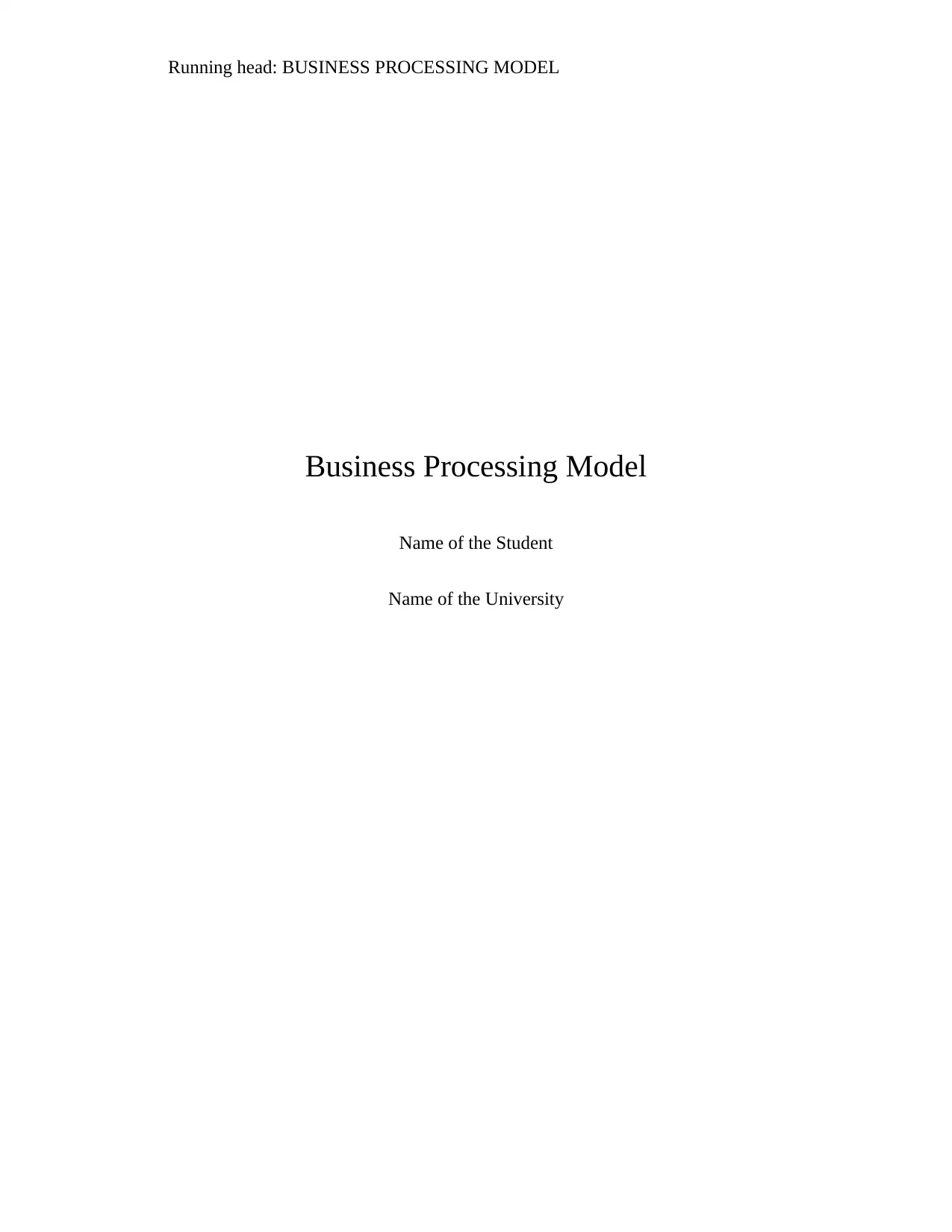
Running head: BUSINESS PROCESSING MODEL
Business Processing Model
Name of the Student
Name of the University
Business Processing Model
Name of the Student
Name of the University
Paraphrase This Document
Need a fresh take? Get an instant paraphrase of this document with our AI Paraphraser
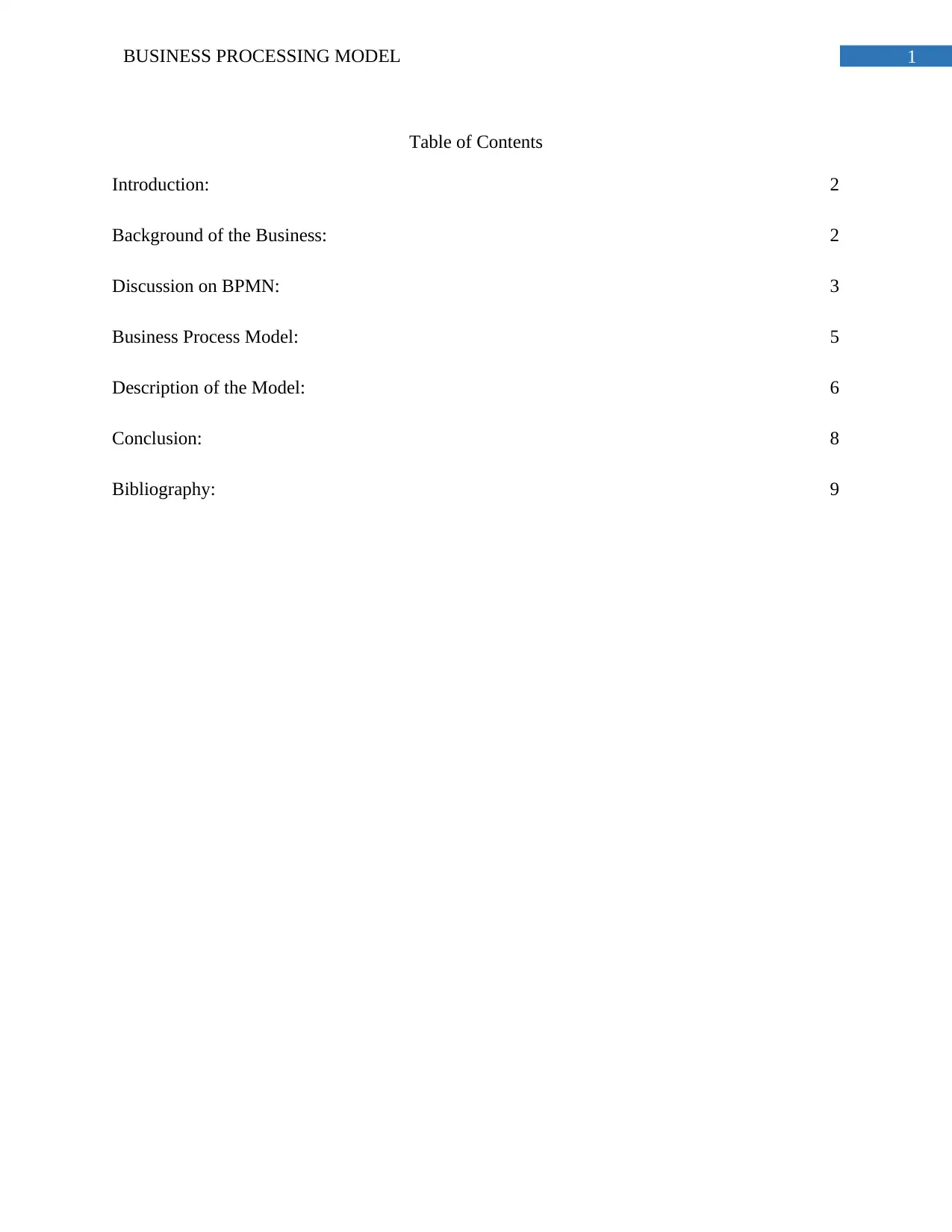
1BUSINESS PROCESSING MODEL
Table of Contents
Introduction: 2
Background of the Business: 2
Discussion on BPMN: 3
Business Process Model: 5
Description of the Model: 6
Conclusion: 8
Bibliography: 9
Table of Contents
Introduction: 2
Background of the Business: 2
Discussion on BPMN: 3
Business Process Model: 5
Description of the Model: 6
Conclusion: 8
Bibliography: 9
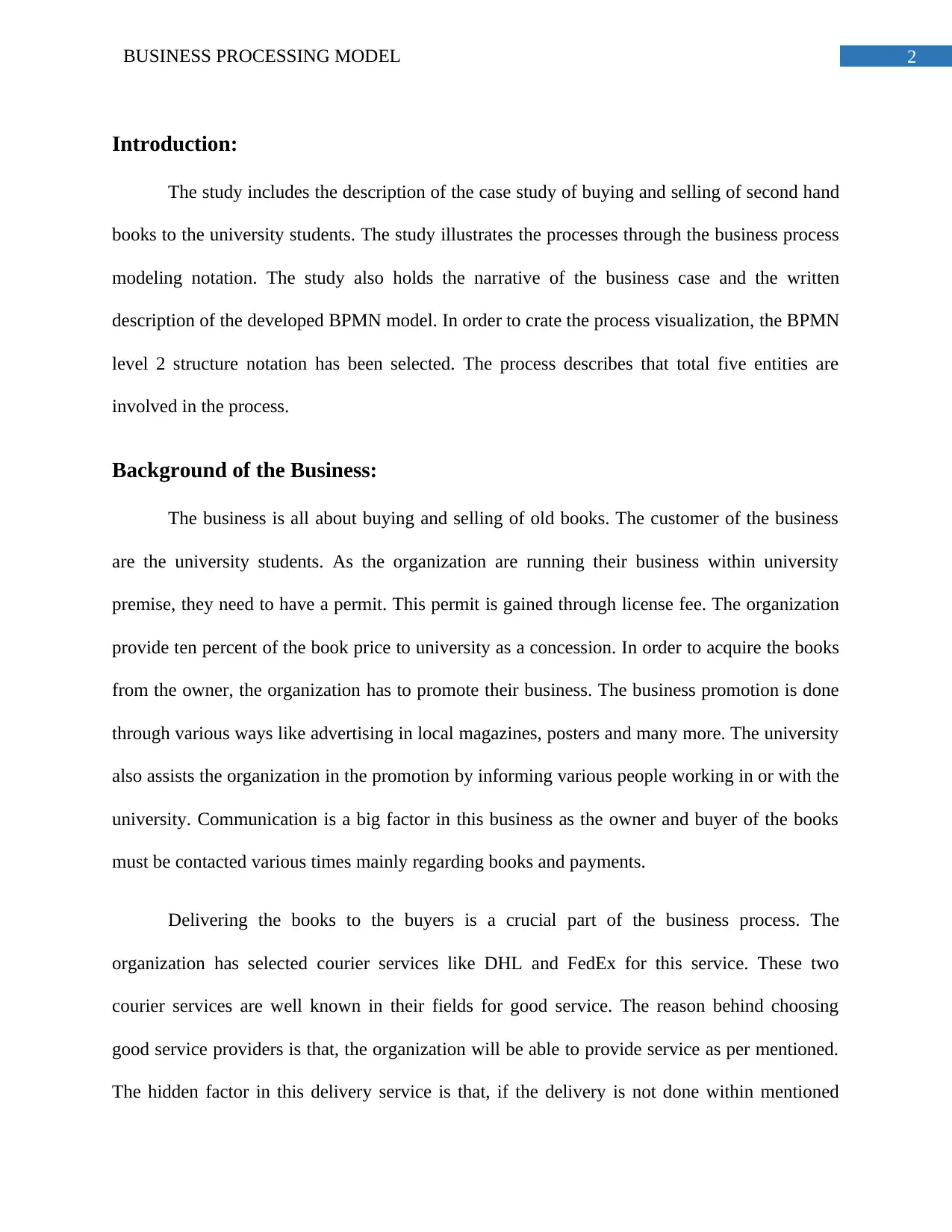
2BUSINESS PROCESSING MODEL
Introduction:
The study includes the description of the case study of buying and selling of second hand
books to the university students. The study illustrates the processes through the business process
modeling notation. The study also holds the narrative of the business case and the written
description of the developed BPMN model. In order to crate the process visualization, the BPMN
level 2 structure notation has been selected. The process describes that total five entities are
involved in the process.
Background of the Business:
The business is all about buying and selling of old books. The customer of the business
are the university students. As the organization are running their business within university
premise, they need to have a permit. This permit is gained through license fee. The organization
provide ten percent of the book price to university as a concession. In order to acquire the books
from the owner, the organization has to promote their business. The business promotion is done
through various ways like advertising in local magazines, posters and many more. The university
also assists the organization in the promotion by informing various people working in or with the
university. Communication is a big factor in this business as the owner and buyer of the books
must be contacted various times mainly regarding books and payments.
Delivering the books to the buyers is a crucial part of the business process. The
organization has selected courier services like DHL and FedEx for this service. These two
courier services are well known in their fields for good service. The reason behind choosing
good service providers is that, the organization will be able to provide service as per mentioned.
The hidden factor in this delivery service is that, if the delivery is not done within mentioned
Introduction:
The study includes the description of the case study of buying and selling of second hand
books to the university students. The study illustrates the processes through the business process
modeling notation. The study also holds the narrative of the business case and the written
description of the developed BPMN model. In order to crate the process visualization, the BPMN
level 2 structure notation has been selected. The process describes that total five entities are
involved in the process.
Background of the Business:
The business is all about buying and selling of old books. The customer of the business
are the university students. As the organization are running their business within university
premise, they need to have a permit. This permit is gained through license fee. The organization
provide ten percent of the book price to university as a concession. In order to acquire the books
from the owner, the organization has to promote their business. The business promotion is done
through various ways like advertising in local magazines, posters and many more. The university
also assists the organization in the promotion by informing various people working in or with the
university. Communication is a big factor in this business as the owner and buyer of the books
must be contacted various times mainly regarding books and payments.
Delivering the books to the buyers is a crucial part of the business process. The
organization has selected courier services like DHL and FedEx for this service. These two
courier services are well known in their fields for good service. The reason behind choosing
good service providers is that, the organization will be able to provide service as per mentioned.
The hidden factor in this delivery service is that, if the delivery is not done within mentioned
⊘ This is a preview!⊘
Do you want full access?
Subscribe today to unlock all pages.

Trusted by 1+ million students worldwide
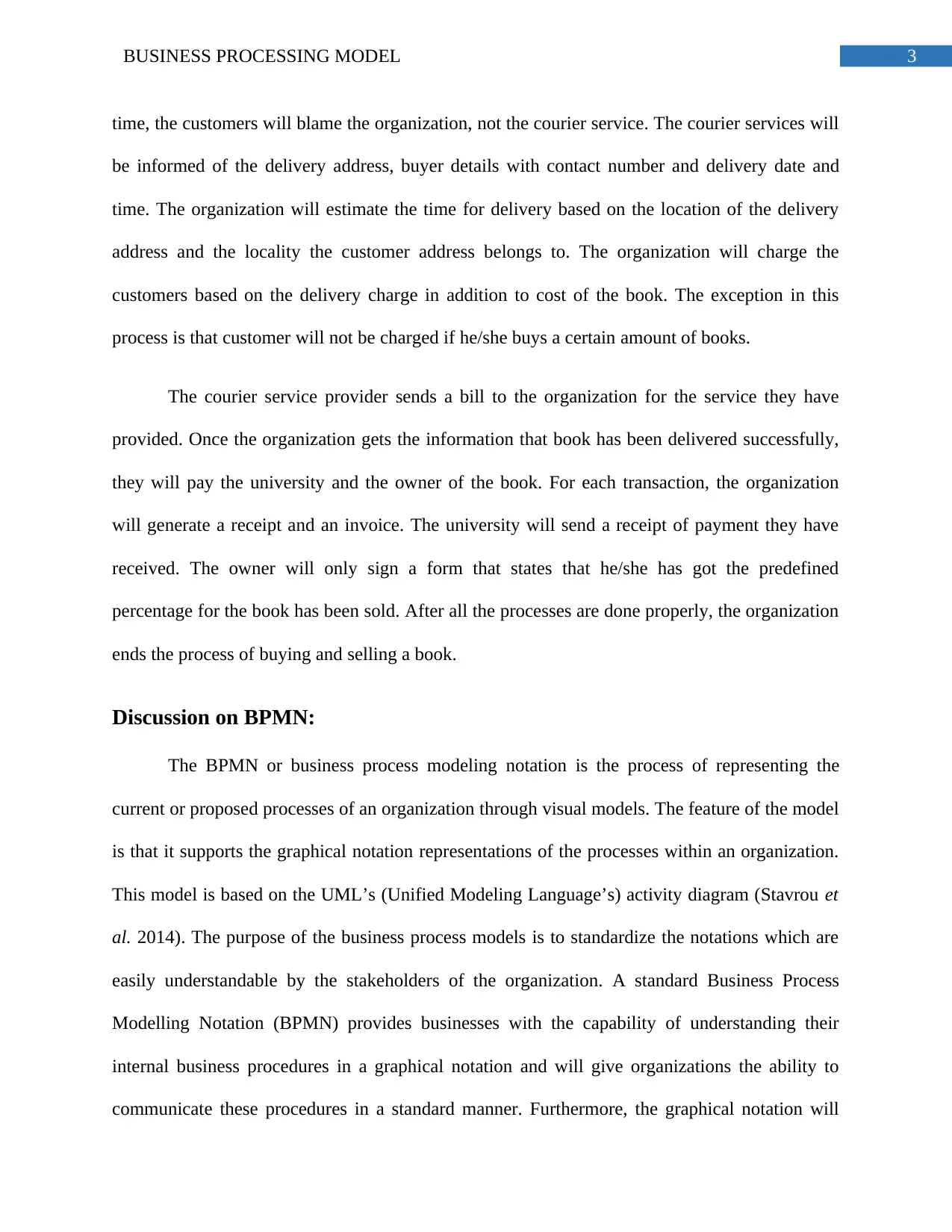
3BUSINESS PROCESSING MODEL
time, the customers will blame the organization, not the courier service. The courier services will
be informed of the delivery address, buyer details with contact number and delivery date and
time. The organization will estimate the time for delivery based on the location of the delivery
address and the locality the customer address belongs to. The organization will charge the
customers based on the delivery charge in addition to cost of the book. The exception in this
process is that customer will not be charged if he/she buys a certain amount of books.
The courier service provider sends a bill to the organization for the service they have
provided. Once the organization gets the information that book has been delivered successfully,
they will pay the university and the owner of the book. For each transaction, the organization
will generate a receipt and an invoice. The university will send a receipt of payment they have
received. The owner will only sign a form that states that he/she has got the predefined
percentage for the book has been sold. After all the processes are done properly, the organization
ends the process of buying and selling a book.
Discussion on BPMN:
The BPMN or business process modeling notation is the process of representing the
current or proposed processes of an organization through visual models. The feature of the model
is that it supports the graphical notation representations of the processes within an organization.
This model is based on the UML’s (Unified Modeling Language’s) activity diagram (Stavrou et
al. 2014). The purpose of the business process models is to standardize the notations which are
easily understandable by the stakeholders of the organization. A standard Business Process
Modelling Notation (BPMN) provides businesses with the capability of understanding their
internal business procedures in a graphical notation and will give organizations the ability to
communicate these procedures in a standard manner. Furthermore, the graphical notation will
time, the customers will blame the organization, not the courier service. The courier services will
be informed of the delivery address, buyer details with contact number and delivery date and
time. The organization will estimate the time for delivery based on the location of the delivery
address and the locality the customer address belongs to. The organization will charge the
customers based on the delivery charge in addition to cost of the book. The exception in this
process is that customer will not be charged if he/she buys a certain amount of books.
The courier service provider sends a bill to the organization for the service they have
provided. Once the organization gets the information that book has been delivered successfully,
they will pay the university and the owner of the book. For each transaction, the organization
will generate a receipt and an invoice. The university will send a receipt of payment they have
received. The owner will only sign a form that states that he/she has got the predefined
percentage for the book has been sold. After all the processes are done properly, the organization
ends the process of buying and selling a book.
Discussion on BPMN:
The BPMN or business process modeling notation is the process of representing the
current or proposed processes of an organization through visual models. The feature of the model
is that it supports the graphical notation representations of the processes within an organization.
This model is based on the UML’s (Unified Modeling Language’s) activity diagram (Stavrou et
al. 2014). The purpose of the business process models is to standardize the notations which are
easily understandable by the stakeholders of the organization. A standard Business Process
Modelling Notation (BPMN) provides businesses with the capability of understanding their
internal business procedures in a graphical notation and will give organizations the ability to
communicate these procedures in a standard manner. Furthermore, the graphical notation will
Paraphrase This Document
Need a fresh take? Get an instant paraphrase of this document with our AI Paraphraser
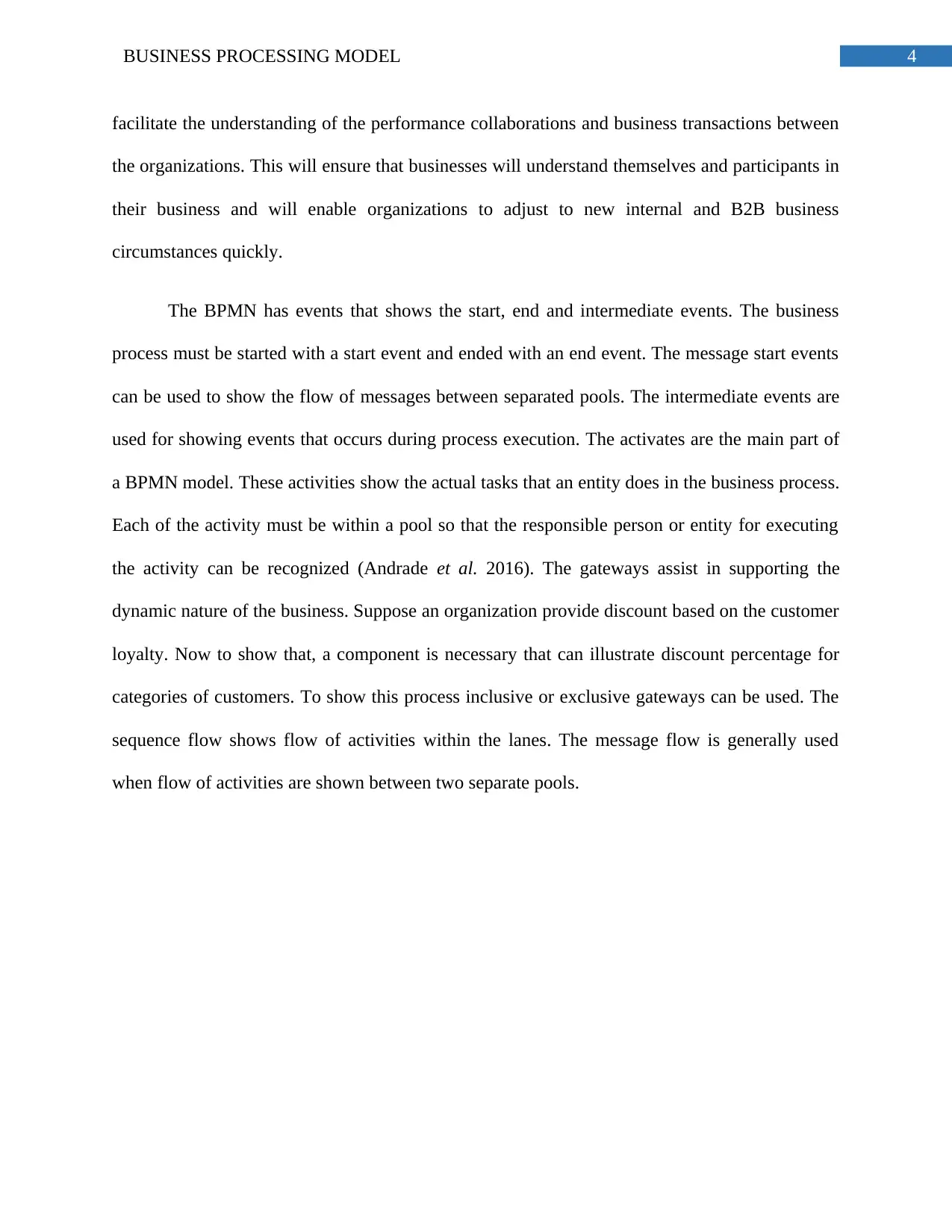
4BUSINESS PROCESSING MODEL
facilitate the understanding of the performance collaborations and business transactions between
the organizations. This will ensure that businesses will understand themselves and participants in
their business and will enable organizations to adjust to new internal and B2B business
circumstances quickly.
The BPMN has events that shows the start, end and intermediate events. The business
process must be started with a start event and ended with an end event. The message start events
can be used to show the flow of messages between separated pools. The intermediate events are
used for showing events that occurs during process execution. The activates are the main part of
a BPMN model. These activities show the actual tasks that an entity does in the business process.
Each of the activity must be within a pool so that the responsible person or entity for executing
the activity can be recognized (Andrade et al. 2016). The gateways assist in supporting the
dynamic nature of the business. Suppose an organization provide discount based on the customer
loyalty. Now to show that, a component is necessary that can illustrate discount percentage for
categories of customers. To show this process inclusive or exclusive gateways can be used. The
sequence flow shows flow of activities within the lanes. The message flow is generally used
when flow of activities are shown between two separate pools.
facilitate the understanding of the performance collaborations and business transactions between
the organizations. This will ensure that businesses will understand themselves and participants in
their business and will enable organizations to adjust to new internal and B2B business
circumstances quickly.
The BPMN has events that shows the start, end and intermediate events. The business
process must be started with a start event and ended with an end event. The message start events
can be used to show the flow of messages between separated pools. The intermediate events are
used for showing events that occurs during process execution. The activates are the main part of
a BPMN model. These activities show the actual tasks that an entity does in the business process.
Each of the activity must be within a pool so that the responsible person or entity for executing
the activity can be recognized (Andrade et al. 2016). The gateways assist in supporting the
dynamic nature of the business. Suppose an organization provide discount based on the customer
loyalty. Now to show that, a component is necessary that can illustrate discount percentage for
categories of customers. To show this process inclusive or exclusive gateways can be used. The
sequence flow shows flow of activities within the lanes. The message flow is generally used
when flow of activities are shown between two separate pools.
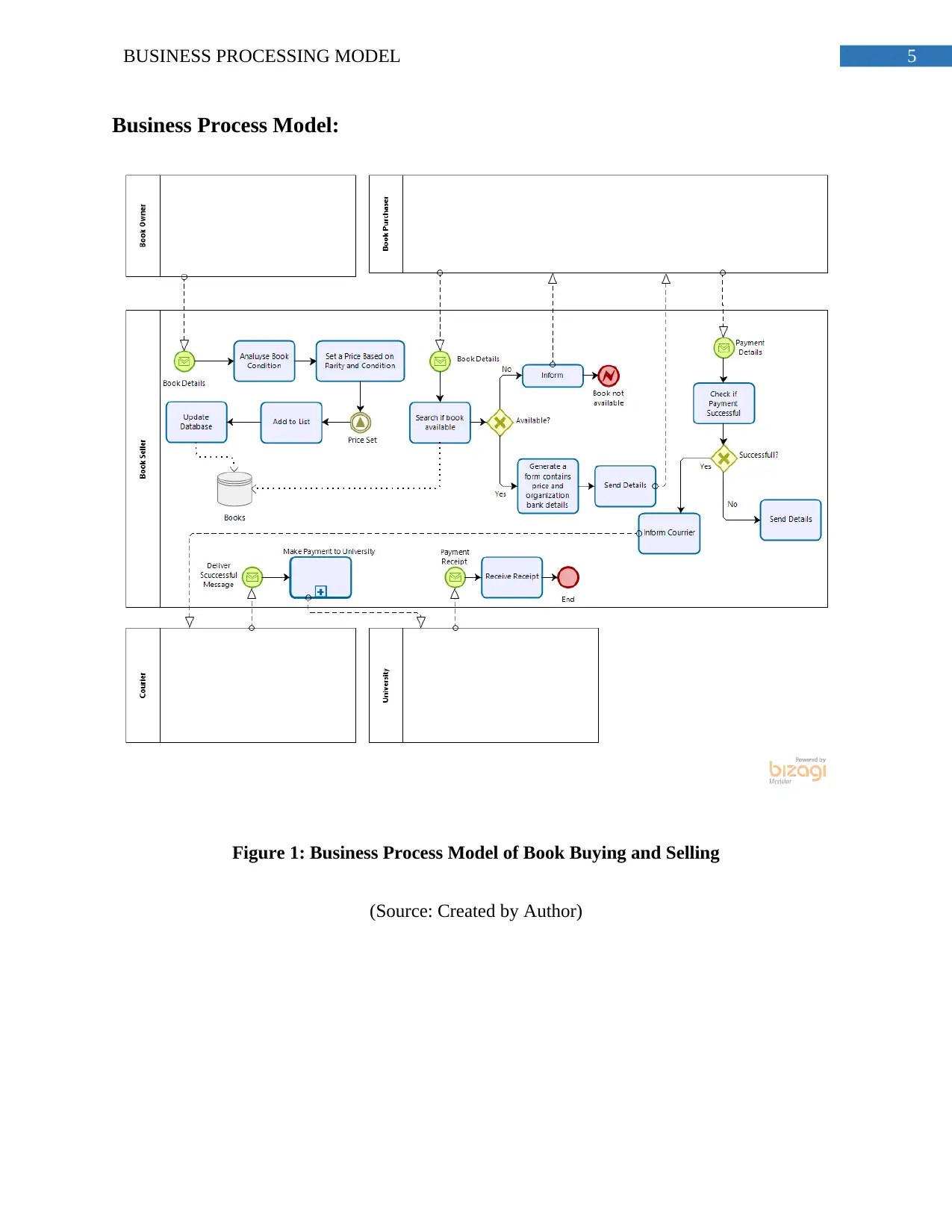
5BUSINESS PROCESSING MODEL
Business Process Model:
Figure 1: Business Process Model of Book Buying and Selling
(Source: Created by Author)
Business Process Model:
Figure 1: Business Process Model of Book Buying and Selling
(Source: Created by Author)
⊘ This is a preview!⊘
Do you want full access?
Subscribe today to unlock all pages.

Trusted by 1+ million students worldwide
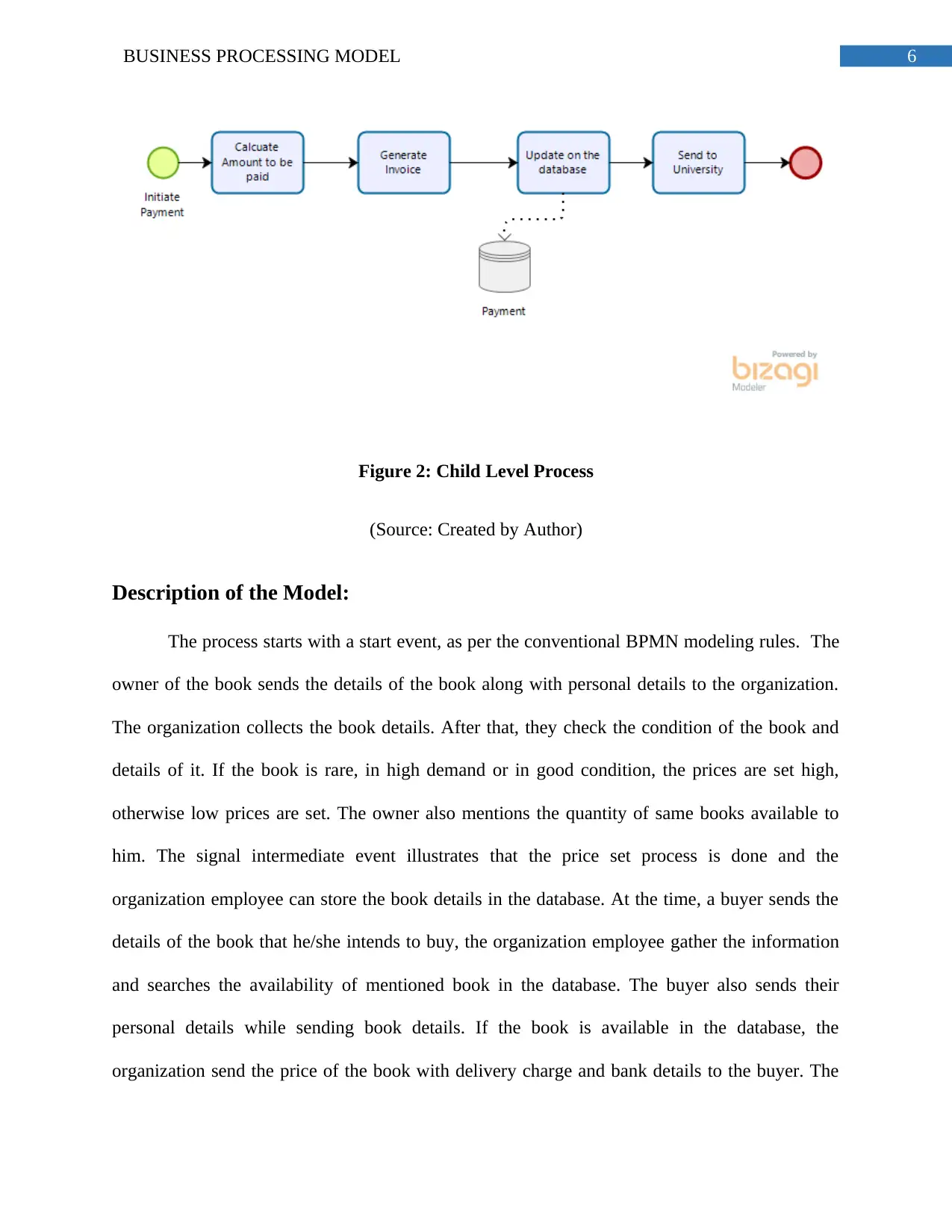
6BUSINESS PROCESSING MODEL
Figure 2: Child Level Process
(Source: Created by Author)
Description of the Model:
The process starts with a start event, as per the conventional BPMN modeling rules. The
owner of the book sends the details of the book along with personal details to the organization.
The organization collects the book details. After that, they check the condition of the book and
details of it. If the book is rare, in high demand or in good condition, the prices are set high,
otherwise low prices are set. The owner also mentions the quantity of same books available to
him. The signal intermediate event illustrates that the price set process is done and the
organization employee can store the book details in the database. At the time, a buyer sends the
details of the book that he/she intends to buy, the organization employee gather the information
and searches the availability of mentioned book in the database. The buyer also sends their
personal details while sending book details. If the book is available in the database, the
organization send the price of the book with delivery charge and bank details to the buyer. The
Figure 2: Child Level Process
(Source: Created by Author)
Description of the Model:
The process starts with a start event, as per the conventional BPMN modeling rules. The
owner of the book sends the details of the book along with personal details to the organization.
The organization collects the book details. After that, they check the condition of the book and
details of it. If the book is rare, in high demand or in good condition, the prices are set high,
otherwise low prices are set. The owner also mentions the quantity of same books available to
him. The signal intermediate event illustrates that the price set process is done and the
organization employee can store the book details in the database. At the time, a buyer sends the
details of the book that he/she intends to buy, the organization employee gather the information
and searches the availability of mentioned book in the database. The buyer also sends their
personal details while sending book details. If the book is available in the database, the
organization send the price of the book with delivery charge and bank details to the buyer. The
Paraphrase This Document
Need a fresh take? Get an instant paraphrase of this document with our AI Paraphraser
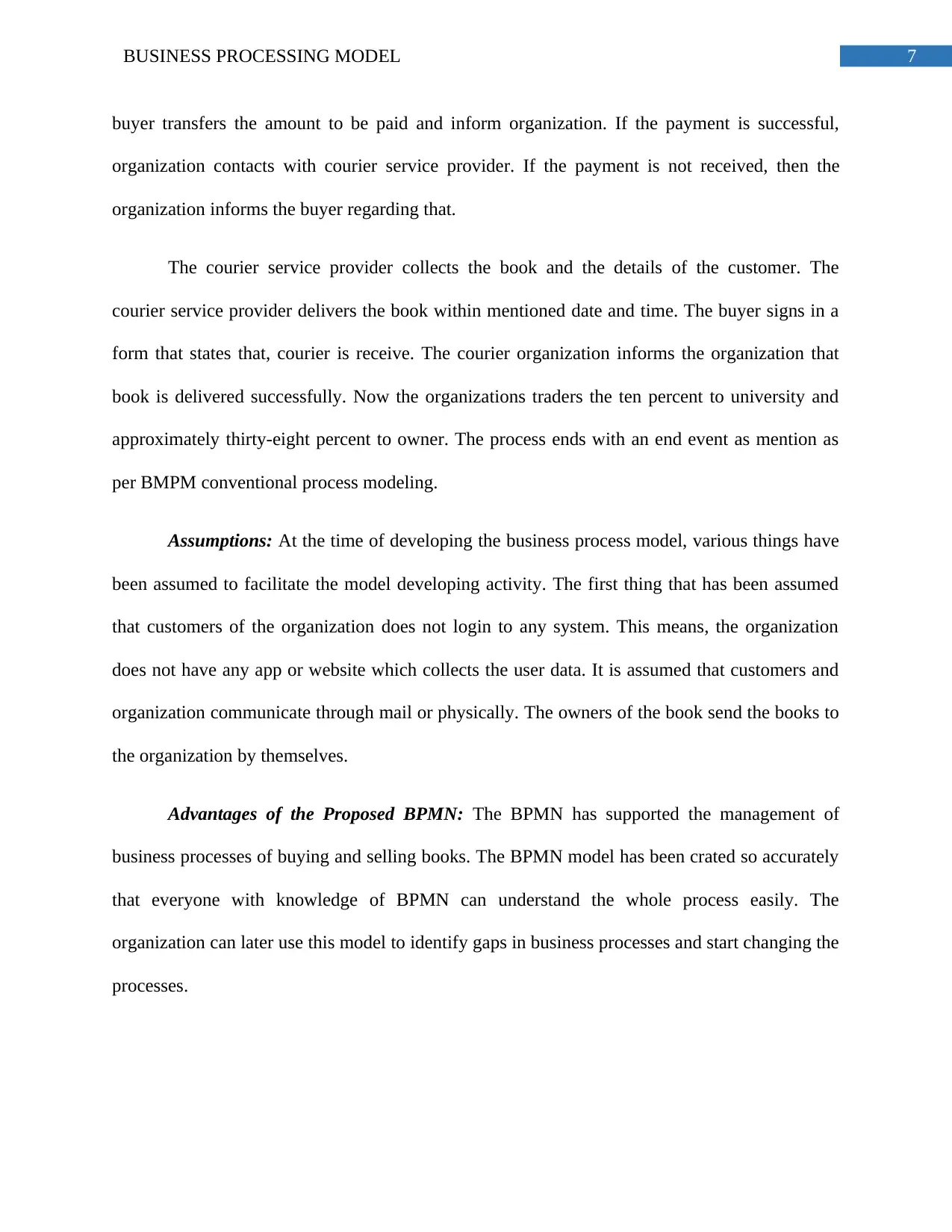
7BUSINESS PROCESSING MODEL
buyer transfers the amount to be paid and inform organization. If the payment is successful,
organization contacts with courier service provider. If the payment is not received, then the
organization informs the buyer regarding that.
The courier service provider collects the book and the details of the customer. The
courier service provider delivers the book within mentioned date and time. The buyer signs in a
form that states that, courier is receive. The courier organization informs the organization that
book is delivered successfully. Now the organizations traders the ten percent to university and
approximately thirty-eight percent to owner. The process ends with an end event as mention as
per BMPM conventional process modeling.
Assumptions: At the time of developing the business process model, various things have
been assumed to facilitate the model developing activity. The first thing that has been assumed
that customers of the organization does not login to any system. This means, the organization
does not have any app or website which collects the user data. It is assumed that customers and
organization communicate through mail or physically. The owners of the book send the books to
the organization by themselves.
Advantages of the Proposed BPMN: The BPMN has supported the management of
business processes of buying and selling books. The BPMN model has been crated so accurately
that everyone with knowledge of BPMN can understand the whole process easily. The
organization can later use this model to identify gaps in business processes and start changing the
processes.
buyer transfers the amount to be paid and inform organization. If the payment is successful,
organization contacts with courier service provider. If the payment is not received, then the
organization informs the buyer regarding that.
The courier service provider collects the book and the details of the customer. The
courier service provider delivers the book within mentioned date and time. The buyer signs in a
form that states that, courier is receive. The courier organization informs the organization that
book is delivered successfully. Now the organizations traders the ten percent to university and
approximately thirty-eight percent to owner. The process ends with an end event as mention as
per BMPM conventional process modeling.
Assumptions: At the time of developing the business process model, various things have
been assumed to facilitate the model developing activity. The first thing that has been assumed
that customers of the organization does not login to any system. This means, the organization
does not have any app or website which collects the user data. It is assumed that customers and
organization communicate through mail or physically. The owners of the book send the books to
the organization by themselves.
Advantages of the Proposed BPMN: The BPMN has supported the management of
business processes of buying and selling books. The BPMN model has been crated so accurately
that everyone with knowledge of BPMN can understand the whole process easily. The
organization can later use this model to identify gaps in business processes and start changing the
processes.
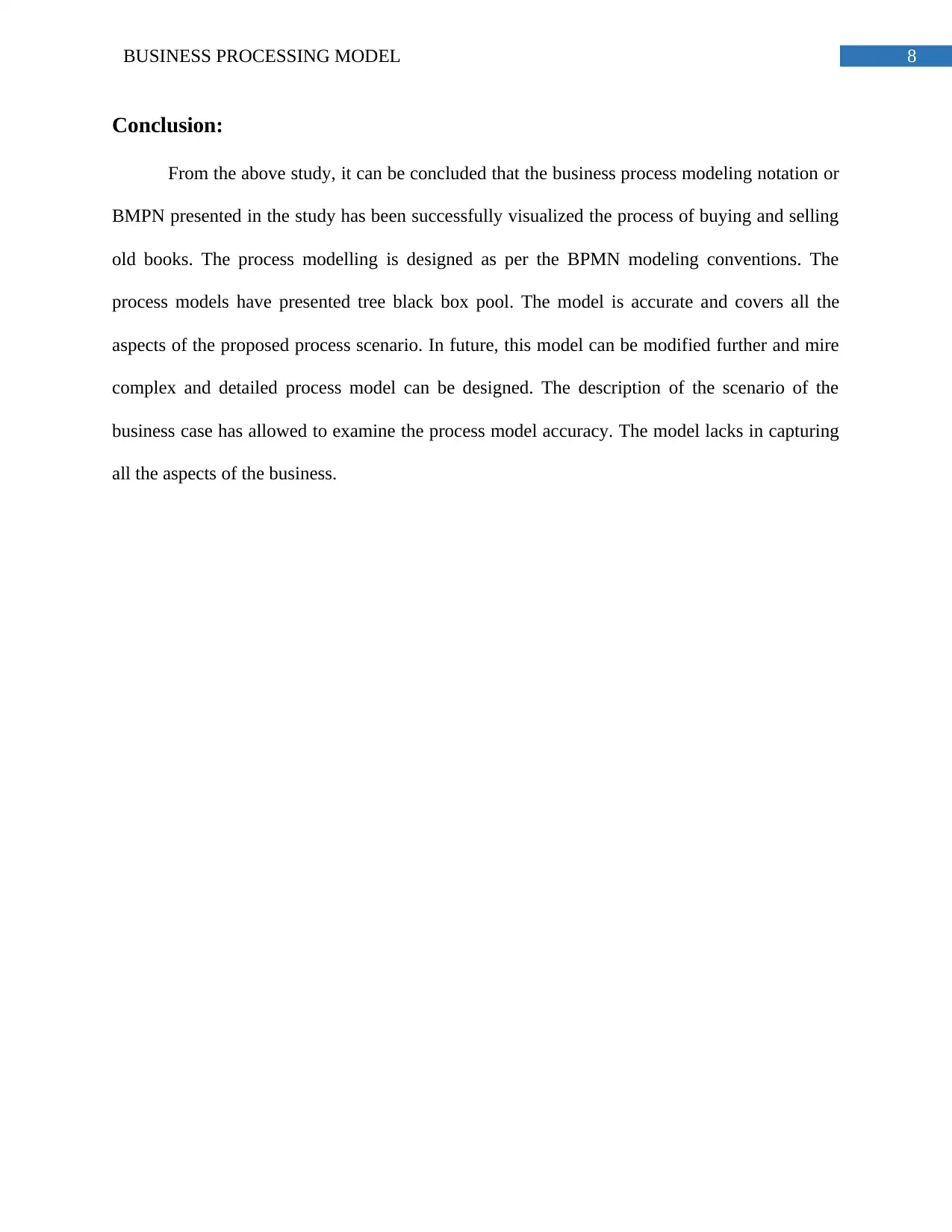
8BUSINESS PROCESSING MODEL
Conclusion:
From the above study, it can be concluded that the business process modeling notation or
BMPN presented in the study has been successfully visualized the process of buying and selling
old books. The process modelling is designed as per the BPMN modeling conventions. The
process models have presented tree black box pool. The model is accurate and covers all the
aspects of the proposed process scenario. In future, this model can be modified further and mire
complex and detailed process model can be designed. The description of the scenario of the
business case has allowed to examine the process model accuracy. The model lacks in capturing
all the aspects of the business.
Conclusion:
From the above study, it can be concluded that the business process modeling notation or
BMPN presented in the study has been successfully visualized the process of buying and selling
old books. The process modelling is designed as per the BPMN modeling conventions. The
process models have presented tree black box pool. The model is accurate and covers all the
aspects of the proposed process scenario. In future, this model can be modified further and mire
complex and detailed process model can be designed. The description of the scenario of the
business case has allowed to examine the process model accuracy. The model lacks in capturing
all the aspects of the business.
⊘ This is a preview!⊘
Do you want full access?
Subscribe today to unlock all pages.

Trusted by 1+ million students worldwide
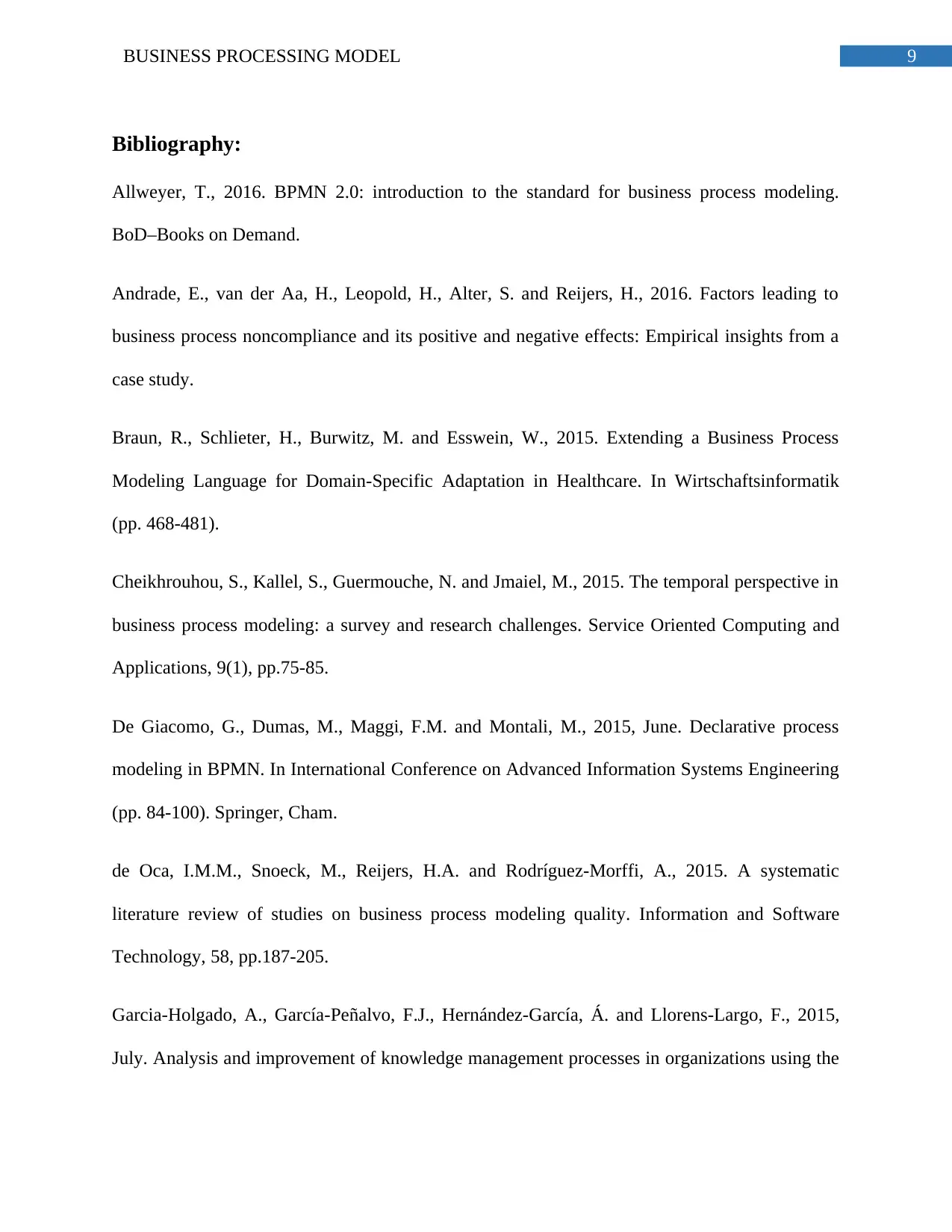
9BUSINESS PROCESSING MODEL
Bibliography:
Allweyer, T., 2016. BPMN 2.0: introduction to the standard for business process modeling.
BoD–Books on Demand.
Andrade, E., van der Aa, H., Leopold, H., Alter, S. and Reijers, H., 2016. Factors leading to
business process noncompliance and its positive and negative effects: Empirical insights from a
case study.
Braun, R., Schlieter, H., Burwitz, M. and Esswein, W., 2015. Extending a Business Process
Modeling Language for Domain-Specific Adaptation in Healthcare. In Wirtschaftsinformatik
(pp. 468-481).
Cheikhrouhou, S., Kallel, S., Guermouche, N. and Jmaiel, M., 2015. The temporal perspective in
business process modeling: a survey and research challenges. Service Oriented Computing and
Applications, 9(1), pp.75-85.
De Giacomo, G., Dumas, M., Maggi, F.M. and Montali, M., 2015, June. Declarative process
modeling in BPMN. In International Conference on Advanced Information Systems Engineering
(pp. 84-100). Springer, Cham.
de Oca, I.M.M., Snoeck, M., Reijers, H.A. and Rodríguez-Morffi, A., 2015. A systematic
literature review of studies on business process modeling quality. Information and Software
Technology, 58, pp.187-205.
Garcia-Holgado, A., García-Peñalvo, F.J., Hernández-García, Á. and Llorens-Largo, F., 2015,
July. Analysis and improvement of knowledge management processes in organizations using the
Bibliography:
Allweyer, T., 2016. BPMN 2.0: introduction to the standard for business process modeling.
BoD–Books on Demand.
Andrade, E., van der Aa, H., Leopold, H., Alter, S. and Reijers, H., 2016. Factors leading to
business process noncompliance and its positive and negative effects: Empirical insights from a
case study.
Braun, R., Schlieter, H., Burwitz, M. and Esswein, W., 2015. Extending a Business Process
Modeling Language for Domain-Specific Adaptation in Healthcare. In Wirtschaftsinformatik
(pp. 468-481).
Cheikhrouhou, S., Kallel, S., Guermouche, N. and Jmaiel, M., 2015. The temporal perspective in
business process modeling: a survey and research challenges. Service Oriented Computing and
Applications, 9(1), pp.75-85.
De Giacomo, G., Dumas, M., Maggi, F.M. and Montali, M., 2015, June. Declarative process
modeling in BPMN. In International Conference on Advanced Information Systems Engineering
(pp. 84-100). Springer, Cham.
de Oca, I.M.M., Snoeck, M., Reijers, H.A. and Rodríguez-Morffi, A., 2015. A systematic
literature review of studies on business process modeling quality. Information and Software
Technology, 58, pp.187-205.
Garcia-Holgado, A., García-Peñalvo, F.J., Hernández-García, Á. and Llorens-Largo, F., 2015,
July. Analysis and improvement of knowledge management processes in organizations using the
Paraphrase This Document
Need a fresh take? Get an instant paraphrase of this document with our AI Paraphraser
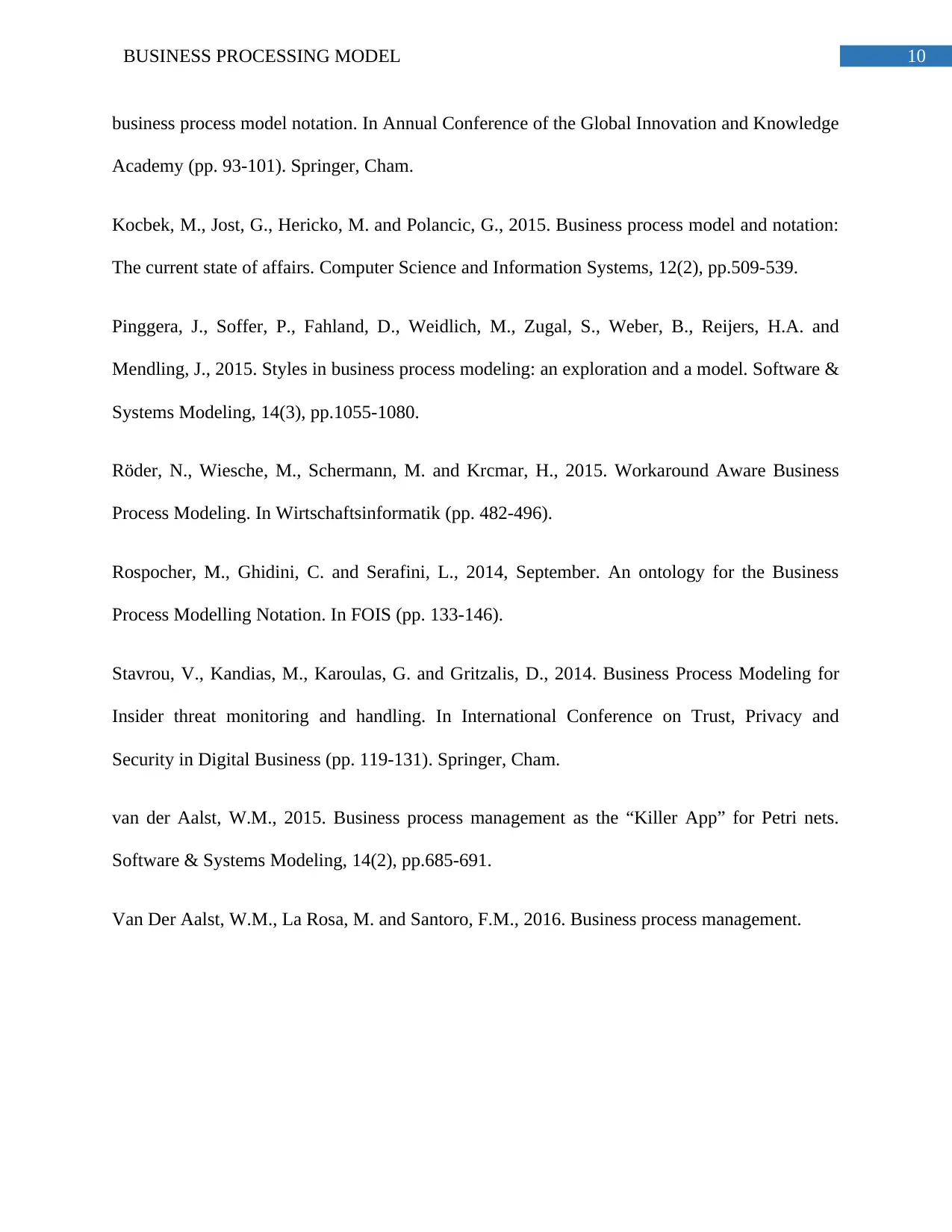
10BUSINESS PROCESSING MODEL
business process model notation. In Annual Conference of the Global Innovation and Knowledge
Academy (pp. 93-101). Springer, Cham.
Kocbek, M., Jost, G., Hericko, M. and Polancic, G., 2015. Business process model and notation:
The current state of affairs. Computer Science and Information Systems, 12(2), pp.509-539.
Pinggera, J., Soffer, P., Fahland, D., Weidlich, M., Zugal, S., Weber, B., Reijers, H.A. and
Mendling, J., 2015. Styles in business process modeling: an exploration and a model. Software &
Systems Modeling, 14(3), pp.1055-1080.
Röder, N., Wiesche, M., Schermann, M. and Krcmar, H., 2015. Workaround Aware Business
Process Modeling. In Wirtschaftsinformatik (pp. 482-496).
Rospocher, M., Ghidini, C. and Serafini, L., 2014, September. An ontology for the Business
Process Modelling Notation. In FOIS (pp. 133-146).
Stavrou, V., Kandias, M., Karoulas, G. and Gritzalis, D., 2014. Business Process Modeling for
Insider threat monitoring and handling. In International Conference on Trust, Privacy and
Security in Digital Business (pp. 119-131). Springer, Cham.
van der Aalst, W.M., 2015. Business process management as the “Killer App” for Petri nets.
Software & Systems Modeling, 14(2), pp.685-691.
Van Der Aalst, W.M., La Rosa, M. and Santoro, F.M., 2016. Business process management.
business process model notation. In Annual Conference of the Global Innovation and Knowledge
Academy (pp. 93-101). Springer, Cham.
Kocbek, M., Jost, G., Hericko, M. and Polancic, G., 2015. Business process model and notation:
The current state of affairs. Computer Science and Information Systems, 12(2), pp.509-539.
Pinggera, J., Soffer, P., Fahland, D., Weidlich, M., Zugal, S., Weber, B., Reijers, H.A. and
Mendling, J., 2015. Styles in business process modeling: an exploration and a model. Software &
Systems Modeling, 14(3), pp.1055-1080.
Röder, N., Wiesche, M., Schermann, M. and Krcmar, H., 2015. Workaround Aware Business
Process Modeling. In Wirtschaftsinformatik (pp. 482-496).
Rospocher, M., Ghidini, C. and Serafini, L., 2014, September. An ontology for the Business
Process Modelling Notation. In FOIS (pp. 133-146).
Stavrou, V., Kandias, M., Karoulas, G. and Gritzalis, D., 2014. Business Process Modeling for
Insider threat monitoring and handling. In International Conference on Trust, Privacy and
Security in Digital Business (pp. 119-131). Springer, Cham.
van der Aalst, W.M., 2015. Business process management as the “Killer App” for Petri nets.
Software & Systems Modeling, 14(2), pp.685-691.
Van Der Aalst, W.M., La Rosa, M. and Santoro, F.M., 2016. Business process management.
1 out of 11
Related Documents
Your All-in-One AI-Powered Toolkit for Academic Success.
+13062052269
info@desklib.com
Available 24*7 on WhatsApp / Email
![[object Object]](/_next/static/media/star-bottom.7253800d.svg)
Unlock your academic potential
Copyright © 2020–2025 A2Z Services. All Rights Reserved. Developed and managed by ZUCOL.





